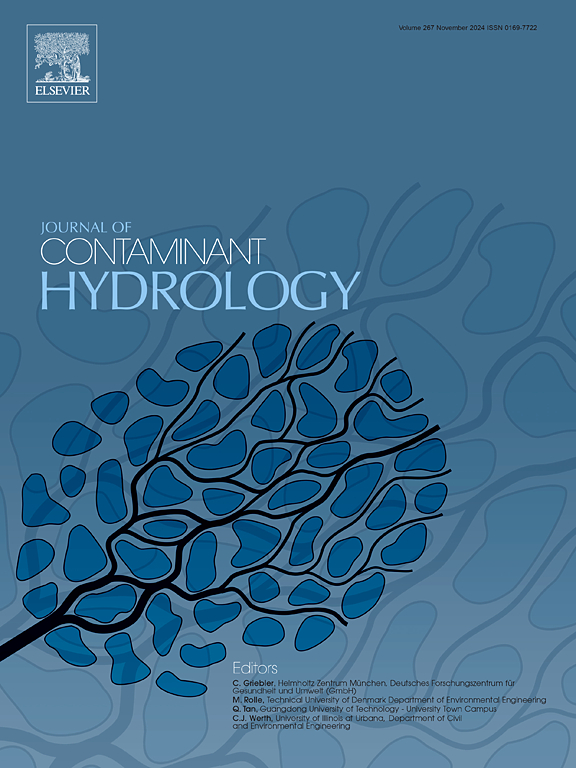湿提和干提城市生活垃圾底灰的风化和微量元素的迁移
IF 3.5
3区 环境科学与生态学
Q2 ENVIRONMENTAL SCIENCES
引用次数: 0
摘要
本研究旨在探讨干法和湿法提取的底灰材料发生风化过程的特点及其对元素排放的影响。为了研究初始水接触的作用,对干燥的底灰进行了湿润实验。通过滴定实验,阐述了废渣的缓冲能力和溶解过程与 pH 值的函数关系,并通过热力学计算确定了溶解度控制相。干底灰显示出高度碱性的原位 pH 条件(pH 值为 12.6)。连续加酸揭示了一个多阶段过程,其特点是在四个不同的缓冲系统中形成和溶解不同的相,包括第一阶段(pH 值为 12.1)的波长石溶解和埃特林岩和 CSH 相的形成、第二阶段(pH 值为 9.7-12.1)的埃特林岩和 CSH 相的溶解、第三阶段(pH 值为 5.5-9.7)的碳酸盐溶解以及第四阶段(pH 值为 5.5)的铝和铁氢氧化物的溶解。湿润的干底灰和湿底灰的先期风化过程导致原位 pH 值降低(pH 值分别为 12.1 和 10.3)。热力学计算表明,含 Ca、S、Al 和 Si 的相是 pH 值稳定的主要原因。作为 pH 值函数的排放趋势与计算溶解度曲线基本一致,干底灰的浓度高于湿底灰。差异,尤其是在干底灰系统中发现的差异,可能与配体(即 DIC、DOC)的存在提高了选定元素(Al、Cu、Zn)的流动性有关。本研究中调查的底灰特征和行为使人们对其行为有了更深入的了解,并突出了干提取底灰在自然和环境相关条件下的浸出能力。本文章由计算机程序翻译,如有差异,请以英文原文为准。
Weathering and trace element mobilisation of MSWI bottom ash from wet and dry extraction
This study aims on the characteristics of occurring weathering processes of dry and wet extracted bottom ash materials and its effects on element emissions. To examine the role of initial water contact, dry bottom ash was experimentally moistened. Titration experiments were performed to elaborate buffer capacities and dissolution processes of the waste residues as a function of pH, and thermodynamic calculations were used to identify the solubility-controlling phases. Dry bottom ash showed highly alkaline in-situ pH conditions (pH 12.6). Continuous acid addition revealed a multi-stage process, which was characterised by the formation and dissolution of different phases across four different buffer systems, including portlandite dissolution and formation of ettringite and CSH phases in the first stage (pH > 12.1), dissolution of ettringite and CSH phases in the second stage (pH 9.7–12.1), carbonate dissolution during the third stage (pH 5.5–9.7), and dissolution of Al- and Fe-hydroxides in the fourth stage (pH < 5.5). Prior weathering processes in the moistened dry bottom ash and wet bottom ash resulted in a reduction of the in-situ pH (pH 12.1 and 10.3, respectively). Thermodynamic calculations suggested that phases containing Ca, S, Al, and Si were mainly responsible for the pH stabilisation. Emission trends as a function of pH generally aligned with calculated solubility curves, with dry bottom ash showing higher concentrations than wet bottom ash. Discrepancies, especially found in the dry bottom ash system, may be associated with elevated the presence of ligands (i.e., DIC, DOC), enhancing the mobility of selected elements (Al, Cu, Zn).
Environmental implications
Bottom ashes investigated in this study are subject to environmental contaminants and potential hazards. Their characterisation and behaviour investigated during this work provides further insight into their behaviour and highlights the enhanced leaching of dry extracted bottom ash under naturally and environmentally relevant conditions.
求助全文
通过发布文献求助,成功后即可免费获取论文全文。
去求助
来源期刊

Journal of contaminant hydrology
环境科学-地球科学综合
CiteScore
6.80
自引率
2.80%
发文量
129
审稿时长
68 days
期刊介绍:
The Journal of Contaminant Hydrology is an international journal publishing scientific articles pertaining to the contamination of subsurface water resources. Emphasis is placed on investigations of the physical, chemical, and biological processes influencing the behavior and fate of organic and inorganic contaminants in the unsaturated (vadose) and saturated (groundwater) zones, as well as at groundwater-surface water interfaces. The ecological impacts of contaminants transported both from and to aquifers are of interest. Articles on contamination of surface water only, without a link to groundwater, are out of the scope. Broad latitude is allowed in identifying contaminants of interest, and include legacy and emerging pollutants, nutrients, nanoparticles, pathogenic microorganisms (e.g., bacteria, viruses, protozoa), microplastics, and various constituents associated with energy production (e.g., methane, carbon dioxide, hydrogen sulfide).
The journal''s scope embraces a wide range of topics including: experimental investigations of contaminant sorption, diffusion, transformation, volatilization and transport in the surface and subsurface; characterization of soil and aquifer properties only as they influence contaminant behavior; development and testing of mathematical models of contaminant behaviour; innovative techniques for restoration of contaminated sites; development of new tools or techniques for monitoring the extent of soil and groundwater contamination; transformation of contaminants in the hyporheic zone; effects of contaminants traversing the hyporheic zone on surface water and groundwater ecosystems; subsurface carbon sequestration and/or turnover; and migration of fluids associated with energy production into groundwater.
 求助内容:
求助内容: 应助结果提醒方式:
应助结果提醒方式:


